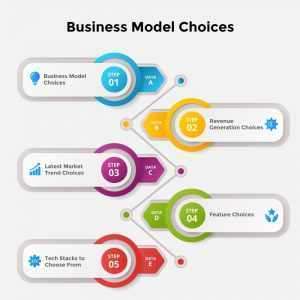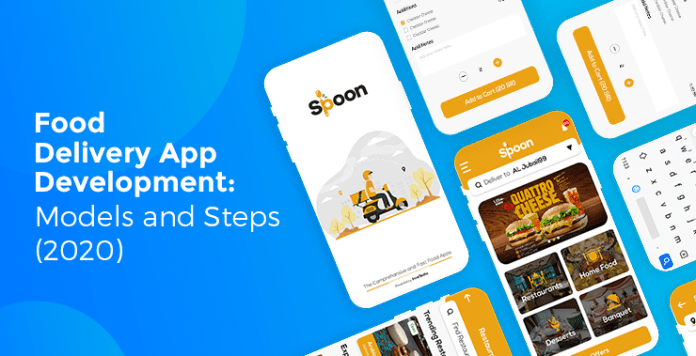Life is busy. With hectic work-from-home routines (been almost a year since COVID-19 has restricted going to workplaces for the majority of us), it is very difficult to manage work along with running a kitchen. And this is where on demand food delivery app comes to our rescue. You order with a click, and the food of your choice is delivered to your doorstep (or workplace).
It should not come as a surprise that on demand food delivery app development companies saw the potential and grabbed this opportunity. Along with the market giants (Zomato, Foodpanda, UberEats, etc.), new start-ups are emerging to exploit the market requirement.
If you are thinking about investing in food delivery app development, now is a perfect time. Online food delivery is estimated to generate a revenue of US$136,431 million worldwide with about 1,213.9 million estimated users. If we talk about the US alone, online food delivery is expected to generate US$26,527 million in 2020, with an estimated number of 111.7 million users. These numbers are promising.
I am going to list below the basic food delivery app development models to choose from, and the steps to their app development. Have a look.

Table of Contents
Step 1: Business Model Choices
In food delivery application development, you have different model choices. I have listed below the three most commonly used models, along with their advantages and limitations to help you choose.
The Order-Only Model
The first-generation of delivery services like JustEat and Grubhub, etc. use this model. The service providers collect restaurants’ menu data and make it accessible to local customers. This improves the market reach of the restaurants. The purpose of this model was to replace the outdated telephone ordering system of restaurants by using the latest mobile and web platforms. Food ordering apps connect the customers to locally available food places. Online food delivery Order-Only generates revenue by charging the restaurants for 7-15% commission per order.
How It Works
- Order is placed on the app or website
- Once received by the restaurant, a confirmation notification is sent to the customer
- Food is delivered by the delivery method chosen by the restaurant
Advantages
- Delivery is prompt
- Limited resources needed
Limitations
- No option to choose a faster delivery service
- Total dependency on restaurants
The Order-and-Delivery Model
This model is a little more advanced than the Order-Only model. Big names like Zomato, Uber, DoorDash, etc., follow this model. The logistics network is provided by the service providers in this model. They receive orders and then forward the requests to the registered local eateries. Their delivery couriers then deliver the food to the customers. The delivery fee is charged on the basis of the distance covered. This model cuts the delivery cost by 20% to 30% because an essential delivery fee is added to every order.
How it works
- The order is placed on the app.
- Customers pay online (some service providers offer Cash or Card On Delivery as well).
- Restaurants get the notification.
- The registered delivery person (closest to the location) picks the order.
- The order is delivered.
Advantages
- The delivery process is controlled by service providers, so they can set the average commission rate at 25%-30%.
- Wide range of eateries to choose from.
Limitations
- Resources such as tech support teams, customer executives, and drivers are required.
- Investment needed for driver training, maintenance, etc.
Cloud Restaurant Model
This model is used by restaurants that do not offer a dining-in space, so their services are provided by deliveries only. Recently, on demand food delivery app developers have incorporated this model with the Order-and-Delivery model to increase the scope of cloud restaurants in the market.
How It Works
- Order is placed on the app
- It is prepared in the Cloud kitchen
- Delivered by the Cloud restaurant’s own delivery service
Advantages
- Limited resources required
- The margin of growth for start-ups
Limitations
- Difficult brand recall due to no physical market presence
- Dependency on delivery providers
Step 2: Revenue Generation Choices
After choosing a business model for your on demand food delivery app development, it’s time to work on revenue generation. Have a look at how food delivery app development services can strategize the monetization:
Delivery Charges
Delivery charges are normally estimated by the distance the delivery person covers. The rate can also be fixed.
Revenue Sharing
This system consists of commission sharing between restaurants and food delivery apps. The commission rate is pre-decided and varies from 15%-40%.
Marketing and Promotions
The marketing charges are normally incorporated in food delivery app development cost. The app generates revenue by providing marketing space to eatery profiles. Restaurants can post their promotions and deal services too. This gives visibility to restaurants and revenue to the app, a win-win!
Surcharge
This method allows for applying surcharge rates during peak hours, i.e., dinner time, festivals, etc.. You must have experienced food delivery apps like Zomato, Uber Eats, etc., charging extra delivery charges during peak hours.
Step 3: Latest Market Trend Choices
If you are working with a food delivery app development company, you know that you cannot miss out on the latest market trends if you want to build a successful food delivery app. The competition is high, and you have to stay a step ahead of your competitors to win.
Orders through Social Media
Did you know that Domino’s Pizza was the first one in the food industry to offer ordering via social media to its customers? Most apps enable this form of ordering now.
Your on demand food delivery app development should enable optimization with social media websites to offer a convenient order replacement experience.
Orders Through Chatbots
It is always a great idea to integrate a chatbot in your food delivery app to make the process easy. For example, Grubhub has integrated Amazon’s Alexa in its development.
Step 4: Feature Choices
Let’s have a look at the features that you can use in your food delivery app development.
Customer Panel
- Signing up: This initializes the customer-restaurant connection with a user sign up. Registration leads to profile creation, where all the necessary data (name, address, contact number, etc.,) are filled in.
- Geo-location: This helps the customers to locate the restaurant on the map. The customer can also track the location of the delivery person once he is en route.
- Listed Restaurants: You can add a list of restaurants along with their ratings and reviews for the customers to see. This makes the selection easy for them.
- Location: You can add two options to the app, a customer can pick the default address from the profile for the food to be delivered, or, update his current location for delivery.
- Cart: It is always helpful to add a food cart in case the customers want to order food from more than one place.
- Payment Method: You can integrate different payment methods to your app.
- Ratings and Reviews: Add the option to review and rate the food.
- Push Notifications: You can promote best offers, food deals, discounts, etc., through this feature.
- Filters: Add the option to filter restaurants based on their location, price, reviews, cuisine type, etc.
- Customer Care: Be available to your customers. A responsive customer care service adds value to an app.
Admin Panel
- Dashboard: Add a centralized dashboard to handle and overview the entire operation. The admin must be able to track order, view inventory updates, etc. via his dashboard.
- Profile Management and Registration: An admin should be able to update profile details of customers, delivery persons, and restaurants. This also helps with the registration of different restaurants on the app. Also, the admin can manage customers, and add/remove depending on their usage.
- Payment Management: the admin should be able to keep a track of all the transactions made via the app. He can view other details like a refund, commission, tax, etc. too.
- Order-Delivery Management: The admin should be able to assign an order delivery to the nearest available delivery person. He can monitor availability of drivers, per order earning, etc.
- Customization of App Features: The admin should be able to make changes to the features of the app, as per his business requirements. This includes the option to reset passwords on customer requests too.
- Promotions and Discounts: An admin should be allowed to run promotions and discounts on the app.
- Marketing: The app should include a feature to run marketing campaigns via social media, emails, texts, etc.
- Restaurant Feedback Management: Based on customer feedback, an admin should be able to manage restaurant registration.
- Push Notifications: Admin should get pop-up notifications for the orders received and delivered.
- Analytics and Reporting: An admin can get useful insights for efficient business management if real-time Analytics is integrated into the app.
Restaurant Panel
- Order Management: This feature allows restaurants to manage their orders. They can view status, update it, give an estimated delivery time to the customers, etc.
- Payment Management: The restaurants can manage the payments, delivery costs, etc., using the admin app.
- Dashboard: This displays new orders received, orders in-process, order cancellations, order completions, total charges, etc.,
- Profile Management: Restaurants can feature their prices, listings, star reviews, etc., for the customers.
- Products Management: New products can be added and updated in the app, and tracked via real-time.
- Order Status: Restaurant managers should be able to accept or reject an order based on the unavailability of the product or delivery person.
- Payment Method: Options should be given to integrating different payment methods (cash on delivery, online payment, etc.,) in the app.
- Discounts/Coupons/Offers Management: Restaurant managers should be able to update discounts, coupons, and the latest offers via the app.
- Alerts Management: Restaurant managers should receive notifications for new orders.
- Payment Tracking: Restaurant managers should be able to update account details for payments.
- Customer Care Management: No food delivery app development can become efficient if it doesn’t have a responsive customer care service.
- Order Availability: The manager should be able to reject an order based on the unavailability of the product or the delivery person.
Delivery Person Panel
- Registration: This should allow the delivery person to register via the app. Safety and security checks should be made before registering a delivery person.
- Auto-Order Assigning: This feature enables auto-assigning of order to the nearest available delivery person based on their location.
- Delivery History: This enables the delivery person to keep a track of their past delivery and payments.
- Direct Call/Chat: The app should enable direct contact between the customer and the delivery person. This ensures clear delivery directions.
- Support: The delivery person should be able to contact the online support team in case he needs any immediate help regarding the delivery.
- Order Management: This allows the delivery person to accept or reject orders based on his convenience.
- Status Management: The delivery person should be able to update the order status after it is delivered.
Step 5: Tech Stacks Choices
These choices would be made based on your business model. Have a look at the technological stack options below.
- Payment Gateway: Stripe, PayPal, Square API, Braintree
- Location: Google Maps, Geo-Location, Google Places API, Core Location Framework
- Direction: Google Maps, MapKit
- Storage: Google Cloud, Digital Ocean, Azure
- Analytics: Google Analytics
- Push Notifications: Firebase Cloud Messaging, Amazon SNS, Urban Airship
- Registration: Gmail SDK, Facebook SDK
Concluding, food delivery app development is not an easy task. But with the help of this step-by-step guide, you can achieve your goal in a shorter span of time. Good luck.


















